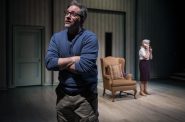Don’t Mess With Medea
Soprana Domonique Labelle’s dramatic performance as Medea highlights concert by Four Nations Ensemble.

Left to right – Colin St. Martin, Loretta O’Sullivan, Andrew Appel, Dominique Labelle, Tatiana Chulochnikova. Photo by Rebecca J. Littman courtesy of Early Music Now.
The Four Nations Ensemble includes Artistic Director and harpsichordist Andrew Appel, violinist Tatiana Chulochnikova, cellist Loretta O’Sullivan and flutist Colin St. Martin. The group has for three decades been a leading presence on the early music scene in New York and nationally. On Saturday the group, performing with guest soprano Domonique Labelle, found the pleasure and the drama of French Baroque music in the final concert of the Early Music Now season at the UWM Zelazo Center.
Baroque music fits a basic pattern. Start with a simple, lovely melody line in violin, flute or voice. Add a bit of decoration. Introduce a dance rhythm sustained by harpsichord and cello in basso continuo roles. The effect can be courtly or a driven country dance. French Baroque composers wrote suites built of dance movements that created a unified, infectious whole. Beneath it all, the music was alive, driven and emotional. The music celebrated life in the early 18th century courts of Louis the XIV and the pleasure seeking courts of his successor, the child king Louis the XV.
Early French Baroque was influenced by Italian composers. In turn, German Baroque composers adapted the suites that the French evolved. German composer G P Telemann was represented by Duuxième Suite – a work “in the style” of the French Baroque. Conversations between flute, violin and cello exploited the different textures of melodic instruments in a more complex work with clear German roots.
Appel plunged into a virtuoso work for solo harpsichord at a breath-taking pace. Jean-Phillippe Rameau‘s Sonata in E minor (from Pieces de Claveçin) combined several traditional dances with two “character” pieces. Precise notes cascaded from the keyboard. Within the flurry, simple melodies emerged, set to irrepressible dance rhythms and settling into the listener’s psyche. Just as a pattern became familiar, a new usually more lively dance was introduced. But the stand out section was a character piece – La Rappel des Oiseaux (Call of the Birds) – that has no discernible rhythmic element. Instead one can discern an active flock of birds, perhaps feeding on the ground. The music became more dense and agitated, as the birds are startled. The short-duration plucked strings of the harpsichord effectively paint an image that a piano version can not.

Left to right – Tatiana Chulochnikova, Andrew Appel, Loretta O’Sullivan. Photo by David Rogers courtesy of Early Music Now.
Labelle sang a set of short dramatic airs – a pair of short expressive, sad songs by Michel Lambert and a more frivolous ditty – Heureux oiseux (Happy birds) by Rameau. St. Martin’s flute was an especially effective companion in the Rameau work. Labelle’s voice matched the pitch and timbre of the flute.
Greek myths of the sorceress Medea have caught the imagination. Medea married Jason, using her powers to enable him to acquire the golden fleece. But when Jason left her for another, Medea killed their children and placed a curse on Jason and his new bride. In L.N. Clérambault’s cantata, Medée, she exposes all of her emotions. She still loves Jason, “Love brings me back in its chains.” But vengeance rules. “Fly demons, fly to serve my fatal fury.” The ensemble’s dramatic reading of the accompaniment complemented the text.
Did Medea really murder her own children? The cantata is silent on the point and other versions of the story vary. But LaBelle left little doubt. Working through the intensely personal episodes, Labelle’s rage boils over, her voice fills the hall, her eyes and gestures reveal her as a sorceress with extraordinary powers. Labelle cast a spell over the Early Music Now audience, bringing the concent to a dramatic close.
Early Music Now will conclude with an end of season gourmet dinner on May 31st. Details and the 2014-2015 season schedule are online. [ http://www.earlymusicnow.org/ ]
Review
-
Ouzo Café Is Classic Greek Fare
 May 23rd, 2024 by Cari Taylor-Carlson
May 23rd, 2024 by Cari Taylor-Carlson
-
‘The Treasurer’ a Darkly Funny Family Play
 Apr 29th, 2024 by Dominique Paul Noth
Apr 29th, 2024 by Dominique Paul Noth
-
Anmol Is All About the Spices
 Apr 28th, 2024 by Cari Taylor-Carlson
Apr 28th, 2024 by Cari Taylor-Carlson






















Dominique LaBelle has the most extraordinary voice, and the mastery and discipline over it to be able to be passionate and dramatic in a unique way! Tatiana Chulocknikova, who began as a child prodigy in Ukraine, is also amazing!